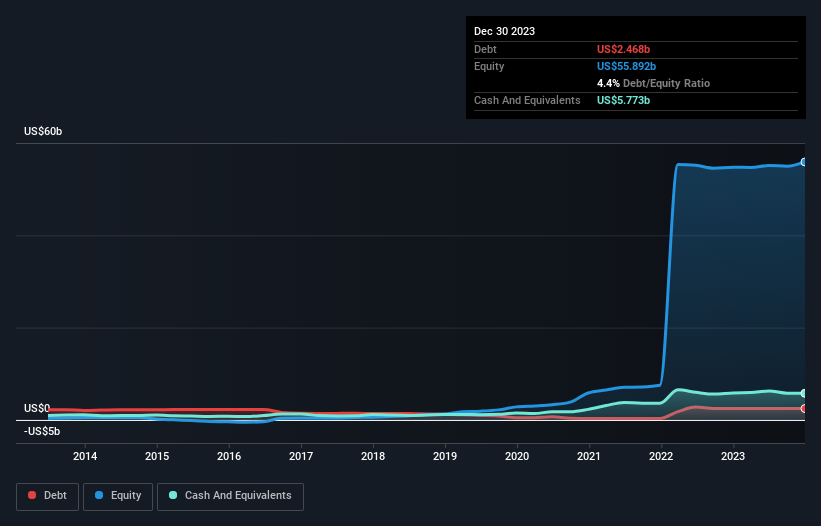Here's Why Advanced Micro Devices (NASDAQ:AMD) Can Manage Its Debt Responsibly
The external fund manager backed by Berkshire Hathaway's Charlie Munger, Li Lu, makes no bones about it when he says 'The biggest investment risk is not the volatility of prices, but whether you will suffer a permanent loss of capital.' So it seems the smart money knows that debt - which is usually involved in bankruptcies - is a very important factor, when you assess how risky a company is. Importantly, Advanced Micro Devices, Inc. (NASDAQ:AMD) does carry debt. But is this debt a concern to shareholders?
What Risk Does Debt Bring?
Debt and other liabilities become risky for a business when it cannot easily fulfill those obligations, either with free cash flow or by raising capital at an attractive price. If things get really bad, the lenders can take control of the business. However, a more common (but still painful) scenario is that it has to raise new equity capital at a low price, thus permanently diluting shareholders. Of course, the upside of debt is that it often represents cheap capital, especially when it replaces dilution in a company with the ability to reinvest at high rates of return. The first step when considering a company's debt levels is to consider its cash and debt together.
See our latest analysis for Advanced Micro Devices
How Much Debt Does Advanced Micro Devices Carry?
The chart below, which you can click on for greater detail, shows that Advanced Micro Devices had US$2.47b in debt in December 2023; about the same as the year before. But on the other hand it also has US$5.77b in cash, leading to a US$3.31b net cash position.
How Healthy Is Advanced Micro Devices' Balance Sheet?
Zooming in on the latest balance sheet data, we can see that Advanced Micro Devices had liabilities of US$6.69b due within 12 months and liabilities of US$5.30b due beyond that. On the other hand, it had cash of US$5.77b and US$5.39b worth of receivables due within a year. So it has liabilities totalling US$835.0m more than its cash and near-term receivables, combined.
Having regard to Advanced Micro Devices' size, it seems that its liquid assets are well balanced with its total liabilities. So it's very unlikely that the US$259.1b company is short on cash, but still worth keeping an eye on the balance sheet. While it does have liabilities worth noting, Advanced Micro Devices also has more cash than debt, so we're pretty confident it can manage its debt safely.
It is just as well that Advanced Micro Devices's load is not too heavy, because its EBIT was down 69% over the last year. Falling earnings (if the trend continues) could eventually make even modest debt quite risky. There's no doubt that we learn most about debt from the balance sheet. But ultimately the future profitability of the business will decide if Advanced Micro Devices can strengthen its balance sheet over time. So if you're focused on the future you can check out this free report showing analyst profit forecasts.
Finally, while the tax-man may adore accounting profits, lenders only accept cold hard cash. While Advanced Micro Devices has net cash on its balance sheet, it's still worth taking a look at its ability to convert earnings before interest and tax (EBIT) to free cash flow, to help us understand how quickly it is building (or eroding) that cash balance. Happily for any shareholders, Advanced Micro Devices actually produced more free cash flow than EBIT over the last three years. There's nothing better than incoming cash when it comes to staying in your lenders' good graces.
Summing Up
While it is always sensible to look at a company's total liabilities, it is very reassuring that Advanced Micro Devices has US$3.31b in net cash. And it impressed us with free cash flow of US$1.1b, being 140% of its EBIT. So we are not troubled with Advanced Micro Devices's debt use. The balance sheet is clearly the area to focus on when you are analysing debt. However, not all investment risk resides within the balance sheet - far from it. To that end, you should be aware of the 2 warning signs we've spotted with Advanced Micro Devices .
Of course, if you're the type of investor who prefers buying stocks without the burden of debt, then don't hesitate to discover our exclusive list of net cash growth stocks, today.
Have feedback on this article? Concerned about the content? Get in touch with us directly. Alternatively, email editorial-team (at) simplywallst.com.
This article by Simply Wall St is general in nature. We provide commentary based on historical data and analyst forecasts only using an unbiased methodology and our articles are not intended to be financial advice. It does not constitute a recommendation to buy or sell any stock, and does not take account of your objectives, or your financial situation. We aim to bring you long-term focused analysis driven by fundamental data. Note that our analysis may not factor in the latest price-sensitive company announcements or qualitative material. Simply Wall St has no position in any stocks mentioned.

 Yahoo Finance
Yahoo Finance 
